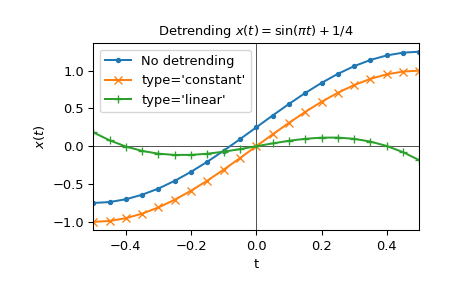scipy.signal.
detrend#
- scipy.signal.detrend(data, axis=-1, type='linear', bp=0, overwrite_data=False)[source]#
沿轴从数据中移除线性或常量趋势。
- 参数:
- dataarray_like
输入数据。
- axisint, optional
对数据进行去趋势处理的轴。默认值为最后一个轴 (-1)。
- type{‘linear’, ‘constant’}, optional
去趋势的类型。如果
type == 'linear'(默认),则从 data 中减去对 data 进行线性最小二乘拟合的结果。如果type == 'constant',则只减去 data 的均值。- bparray_like of ints, optional
一系列断点。如果给定,则对两个断点之间 data 的每个部分执行单独的线性拟合。断点指定为 data 中的索引。此参数仅在
type == 'linear'时有效。- overwrite_databool, optional
如果为 True,则执行原地去趋势处理并避免复制。默认为 False
- 返回:
- retndarray
去趋势后的输入数据。
另请参阅
numpy.polynomial.polynomial.Polynomial.fit创建最小二乘拟合多项式。
说明
去趋势可以解释为减去最小二乘拟合多项式:将参数 type 设置为“constant”对应于拟合零次多项式,“linear”对应于拟合一次多项式。请参阅下面的示例。
示例
以下示例对函数 \(x(t) = \sin(\pi t) + 1/4\) 进行去趋势处理
>>> import matplotlib.pyplot as plt >>> import numpy as np >>> from scipy.signal import detrend ... >>> t = np.linspace(-0.5, 0.5, 21) >>> x = np.sin(np.pi*t) + 1/4 ... >>> x_d_const = detrend(x, type='constant') >>> x_d_linear = detrend(x, type='linear') ... >>> fig1, ax1 = plt.subplots() >>> ax1.set_title(r"Detrending $x(t)=\sin(\pi t) + 1/4$") >>> ax1.set(xlabel="t", ylabel="$x(t)$", xlim=(t[0], t[-1])) >>> ax1.axhline(y=0, color='black', linewidth=.5) >>> ax1.axvline(x=0, color='black', linewidth=.5) >>> ax1.plot(t, x, 'C0.-', label="No detrending") >>> ax1.plot(t, x_d_const, 'C1x-', label="type='constant'") >>> ax1.plot(t, x_d_linear, 'C2+-', label="type='linear'") >>> ax1.legend() >>> plt.show()

或者,NumPy 的
Polynomial也可以用于去趋势处理>>> pp0 = np.polynomial.Polynomial.fit(t, x, deg=0) # fit degree 0 polynomial >>> np.allclose(x_d_const, x - pp0(t)) # compare with constant detrend True >>> pp1 = np.polynomial.Polynomial.fit(t, x, deg=1) # fit degree 1 polynomial >>> np.allclose(x_d_linear, x - pp1(t)) # compare with linear detrend True
请注意,
Polynomial也允许拟合更高次的多项式。请参阅其文档以了解如何提取多项式系数。